Abstract
A passively Q-switched Thulium-doped fiber laser based on glycerin as the saturable absorber is experimentally demonstrated for the first time. The saturable absorber consists of two FC/PC connectors aligned within a mechanical fiber-fiber coupler, with the intervening gap filled with glycerin. Such a saturable absorber is integrated into a compact ring cavity, enabling passive Q-switched laser operation. Starting at a minimum pump power of 1.7 W, Q-switched pulses with a central wavelength of 1946 nm are obtained. At the maximum pump power of 2.4 W, the laser generates pulses with a duration of approximately 2 µs, a repetition rate of 26.7 kHz, and a pulse energy of 1.08 µJ. To the best of our knowledge, this is the first demonstration of passively Q-switched laser operation utilizing a glycerin-based saturable absorber for generating pulsed emission at the 2-µm wavelength region. This breakthrough represents a significant advancement in fiber laser technology, introducing a novel and efficient approach to pulse generation.
1. Introduction
Q-switched Thulium-doped fiber lasers (TDFLs) have garnered significant interest in recent years due to their ability to generate high-energy optical pulses around the two-micrometer wavelength region. This spectral window enables a broad range of applications, including medicine (e.g., Urinary Lithotripsy; soft tissue ablation), LIDAR, and materials processing [1,2,3,4].
There are two primary mechanisms for achieving Q-switching (QS): active (AQS) and passive QS (PQS). Unlike AQS, PQS offers several advantages, including compactness, simplicity, and design flexibility. PQS operation is typically achieved by incorporating a saturable absorber (SA) inside the cavity to modulate the losses. To ensure stable PQS operation, the SA must meet the following characteristics. Firstly, its saturation energy must be much lower than that of the gain medium. Secondly, its recovery time must significantly exceed the pulse duration. Still, it must be fast enough to ensure that when a pulse is emitted, the loss recovers long before the gain. Lastly, its modulation depth must be large enough to change the loss within the cavity, and the non-saturable losses must be minimal [5]. Additionally, the SA must have a high damage threshold to support high-pulse energy operation.
A wide range of materials has been used as SAs in PQS TDFLs, such as semiconductor saturable absorber mirror (SESAM), graphene, gold nanoparticles film, carbon nanotubes (CNTs), rare-earth-doped fibers, Ferroferric oxide (Fe3O4), and even alcohol [6,7,8,9,10,11,12,13,14]. SESAMs have several drawbacks, including complex and expensive fabrication and challenging integration into the laser cavity. While graphene-based and CNTs-based SAs offer advantages such as low manufacturing costs and low saturation power, their limited damage threshold restricts their use in high-power fiber lasers. SAs based on rare-earth-doped fibers have emerged as an alternative due to their ease of integration into the cavity. However, they suffer from the constraint that varying the characteristics of the PQS pulses is complicated, as these depend largely on the doped-fiber manufacturing process. Anhydrous alcohol has been reported as SA for both QS and mode-locking (ML) operations [14,15]. However, its significant limitation is its high volatility.
Recently, W. Zhang et al. proposed and demonstrated bright and dark ML pulses in an Erbium-doped fiber laser (EDFL) using glycerin as the SA [16]. Glycerin exhibits broadband absorption from 1500 to 2000 nm, attributed to various covalent bonds’ stretching and flexural vibrations. Specifically, the absorption of glycerin near the 2 µm wavelength is correlated with the flexural vibration of O-H bonds [17,18]. In this sense, further details on the characteristics of the proposed glycerin-based SA, including its measured absorption spectrum, can be found in [16,17,18]. Hence, the combination of glycerin’s broad absorption spectrum and its suitable nonlinear saturable absorption enables the successful implementation of QS or ML operations in EDFLs or TDFLs using a glycerin-based SA.
In contrast to diverse materials used as SAs (see Table 1), glycerin is a cost-effective, readily accessible liquid that does not require synthesis or complex fabrication. Furthermore, its low volatility provides enhanced operational stability compared to alcohol-based SA, making it an attractive candidate for passive QS.
In this work, we report—for the first time to our knowledge—the implementation of PSQ TDFL using glycerin as the SA. We experimentally demonstrate that, by optimizing the glycerin layer, stable QS pulses can be generated at a central wavelength of 1946 nm. Under a maximum pump power of 2.4 W, the laser achieves a minimum pulse duration of 2.03 µs, a repetition rate of 26.7 kHz, and a maximum average output power of 30 mW, corresponding to a pulse energy of 1.08 µJ and a peak power of 533 mW.
These results highlight the potential of glycerin as a practical and scalable alternative to the various materials used as SAs, particularly for the development of low-cost and compact Q-switched laser systems operating around 2-μm. The demonstrated performance supports the development of simpler laser architectures that remain stable within a practical operating range, making them highly attractive for eye-safe applications in medicine, surgery, manufacturing, and defense [19]. Moreover, high-energy Q-switched pulses at this wavelength are well-suited for materials processing [4], offering a more efficient and easier-to-implement alternative to mode-locked lasers, which typically require precise and delicate control of intracavity losses [20].
2. Materials and Methods
2.1. Experimental Configuration of the TDFL
A Q-switched TDFL has been constructed to assess the efficacy of the glycerin-based SA around the 2-µm wavelength region. As illustrated in Figure 1, a 0.8-m double-clad Thulium-doped fiber (DCTDF, Nufern SM-TDF-10P/130-HE, East Granby, US) with inner cladding diameter of 130 µm, numerical aperture (NA) of 0.46 with cladding absorption of 9 dB/m at 793 nm, and core diameter of 10 µm with NA of 0.15, was utilized as the gain medium and pumped with a 793 nm laser source through a (2 + 1) × 1 pump combiner (Multimode pump & signal combiner). The signal input signal input and output were of type SM-GDF-10/130/-15FA and SM-GDF-10/130-15FA, respectively. A polarization-independent isolator (PI-ISO) was placed between the TDF and the SA to ensure unidirectional laser operation. A three-paddle polarization controller (PC) was inserted to optimize the Q-switched pulses, and a 75:25 optical coupler (OC) was spliced between the PC and the SA for measurements at the 25% output port. The glycerin-based SA was inserted between the 75% output port of the OC and the PI-ISO pigtail.
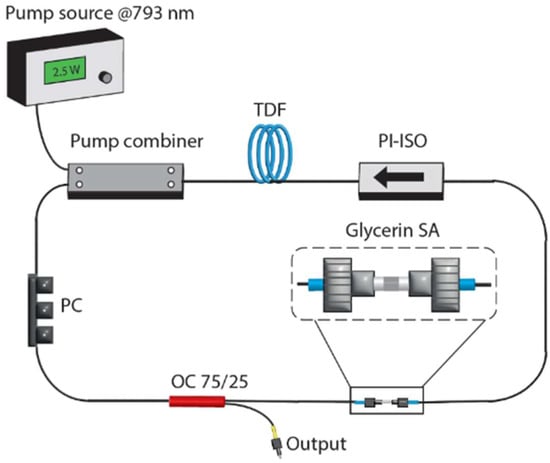
Figure 1.
Experimental setup of the TDFL based on glycerin as the SA. The inset illustrates a schematic diagram of the SA.
The glycerin-based SA consisted of two FC/PC connectors and a mechanical fiber-to-fiber coupler. The coupler was filled with a certain amount of glycerin, and the two FC/PC connectors were inserted, creating a glycerin-filled gap between them. To prevent the degradation of glycerin SA due to high-power pump-induced heat buildup, the entire setup was immersed in a container filled with glycerin. The glycerin gap between the end facets of both connectors functioned as the SA, owing to glycerin’s absorption characteristics near the 2 µm wavelength region.
Specifically, glycerin’s non-volatile nature simplifies the fabrication process, representing a distinctive benefit of using glycerin-based SA.
The QS pulses were detected by a high-speed photodetector (12.5 GHz bandwidth and 28 ps rise/fall time) and monitored through a 2.5-GHz bandwidth oscilloscope. The optical spectrum was measured using an optical spectrum analyzer (OSA, Yokowa AQ6375, Musashino, Japan) with a maximum resolution of 50 pm. The laser output power is quantified using a thermal optical power meter (Thorlabs PM310D, Newton, NJ, USA). The radio frequency (RF) spectrum of the QS pulses was detected using a high-speed photodetector and measured by using a spectrum analyzer (Agilent, N9344C Handheld spectrum analyzer, Santa Clara, CA, USA) with a resolution ranging from 10 Hz to 3 MHz and a frequency span extending from 100 Hz to 20 GHz.
2.2. Experimental Setup for SA Characterization
By optimizing the glycerin gap between the two FC/PC connectors, stable PQS operation of the TDFL was achieved. The nonlinear absorption of glycerin was then measured using a balanced twin detector system (similar to [14]), as illustrated in Figure 2a. The setup consisted of a homemade mode-locked TDFL with a central wavelength of 1996 nm, a pulse duration of 3.43 ps, and a repetition rate of 1.31 MHz [21], which served as the pump source. The laser output was coupled to a PI-ISO to prevent back reflections, followed by a variable optical attenuator (VOA) to control the input power. A 50/50 OC was employed after the VOA to split the optical power equally.
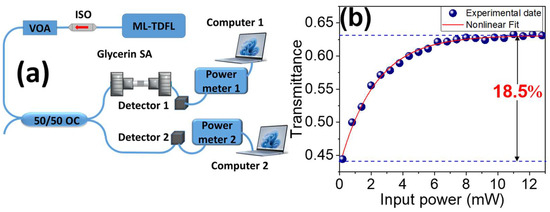
Figure 2.
(a) Experimental setup for nonlinear absorption measurement of the glycerin-SA. (b) Transmittance curve and the corresponding fitting curve.
The output power was measured as a reference in one arm of OC, while the SA was spliced in the other arm for power transmittance measurement. Two thermal detectors and power meters, calibrated for 2000 nm, were employed to measure simultaneously the reference power and the power transmitted through the SA. Data from both channels were recorded using two computers. Figure 2b shows the measured transmission rate results of glycerin. A typical saturable absorption transmittance is observed, and the experimental data fit well with the standard saturable absorption formula [22]. According to the curve fitting in Figure 2b, the modulation depth of the glycerin-based SA is 18.5%, and the non-saturable loss is 36.8%. It is worth mentioning that the glycerin used is commercial (‘Corona’ brand, labeled as 100% pure)
Due to the absence of a microscope in our laboratory, the thickness of the glycerin gap could not be measured directly. Instead, it was estimated using the Beer–Lambert law based on experimental data. Using the absorption coefficient of glycerin 1951 nm (approximately 0.8 cm−1 [20]) and the minimum transmittance value (Tmin) from the curve in Figure 2b, the thickness of the glycerin gap formed between the FC/PC connectors was calculated to be ~3.7 mm.
To optimize the SA performance, the glycerin-filled gap between the two FC/PC connectors was manually adjusted. This parameter directly influences the modulation depth and, consequently, the ability to achieve QS operation. After several experimental iterations, stable pulsed operation was consistently obtained with a glycerin gat thickness of approximately 3.7 mm, corresponding to a modulation depth of 18.5%. Variations from this optimal thickness—either larger or smaller—resulted in the suppression of pulse generation, indicating the sensitivity of the QS regime to the absorber’s optical properties at this wavelength and confirming that this configuration is optimal for our setup.
The relaxation time of glycerin is on the order of picoseconds, associated with transitions between molecular vibrational energy levels [17]. Its response time is around a few hundred picoseconds, making it suitable for generating mode-locked (ML) pulses [16]. However, such an ultrafast response is not ideal for QS pulse generation, where slightly slower recovery dynamics are generally preferred [5].
In our case, we hypothesize that the high pump power injected into the glycerin-based SA causes localized heating due to strong optical absorption, which in turn may induce molecular redistribution or structural rearrangement. These thermally driven processes can introduce slower recovery components, resulting in a recovery time that is significantly longer than the intrinsic molecular relaxation time and enabling Q-switched operation. This hypothesis is supported by the observation that at pump powers around 2.5 W, overheating of the glycerin layer appears to significantly delay its recovery, resulting in unstable Q-switching behavior.
3. Results and Discussion
Before inserting the SA inside the cavity, we made sure that there was no pulsed operation. To do this, the pump power was varied from zero to a maximum of 2.5 W, and the PC paddles were adjusted across their full range. As a result, only continuous wave (CW) operation was observed. After placing the glycerin-based SA into the laser cavity and with a modulation depth of 18.5%, stable QS pulses were observed at a minimum pump power of 1.7 W. The high threshold required to achieve PQS operation may stem from significant losses associated with inserting the FC/PC connectors separated by the glycerin gap and the absorption in the glycerin layer. The PC was adjusted to optimize the QS pulses.
Figure 3 depicts the optical spectrum and the profile of the QS pulse corresponding to a pump power of 2.4 W. The central wavelength of the TDFL is shown in Figure 3a, located at 1946 nm with a measured 3-dB bandwidth of ~50 pm. Figure 3b displays the QS waveform, exhibiting a pulse duration of 2.03 µs.
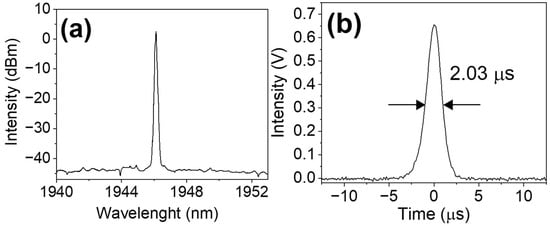
Figure 3.
(a) Optical spectrum of the TDFL; (b) Profile of the QS pulse. Both measurements were obtained at the pump power of 2.4 W.
A typical QS pulse train against varying pump power is shown in Figure 4. As the pump power increases, the pulse output remains stable, the pulse-to-pulse period decreases, and the pulse width narrows, typical of PQS operation. While the pulse trains are presented within the range of 1.7 to 2.5 W, stable QS pulses persist up to 2.4 W. Beyond this point, however, instead of the expected decrease in pulse spacing, the period increases very slightly, i.e., the repetition rate decreases (see Figure 5b). We attribute this behavior to the degradation of the glycerin properties by heat accumulation induced by the high power of the laser, leading to unstable Q-switched behavior.
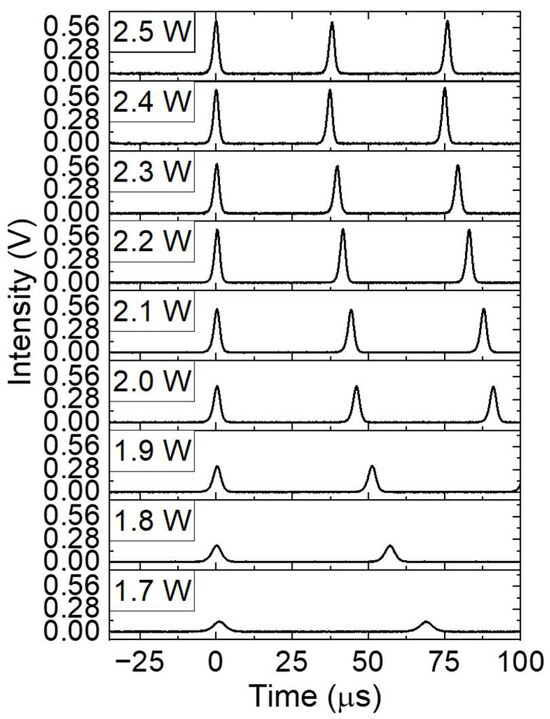
Figure 4.
QS pulse trains at different pump power levels between 1.7 W and 2.5 W with a tuning step of 0.1 W.
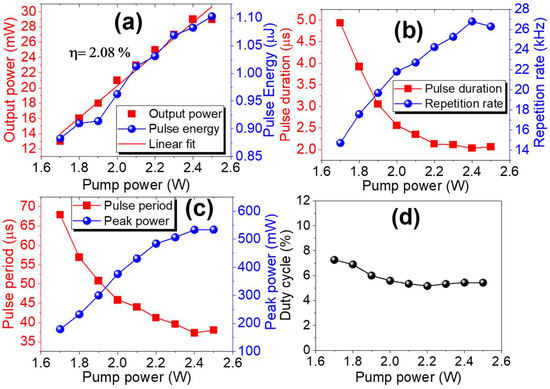
Figure 5.
Lasing characteristics of the PQS-TDFL in function of the pump power. (a) output power and pulse energy; (b) pulse duration and repetition rate; (c) pulse period and peak power. (d) duty cycle.
Figure 5 shows the characteristics of the QS-TDFL as a function of the pump power. The variation of the average output power and the pulse energy is shown in Figure 5a. The output power ranges from 13 to 29 mW, with a slope efficiency of 2.03%, while the pulse energy increases almost linearly from 0.88 to 1.10 µJ as the pump power increases from 1.7 to 2.4 W. Although the system delivers 25% output, the slope efficiency relative to the pump power remains relatively low, primarily due to the high insertion loss introduced by the glycerin layer placed between the two FC/PC connectors. However, within the pump power range of 1.7 to 2.4 W, the system exhibits reliable operation and characteristic Q-switched behavior, validating the feasibility of the TDFL design incorporating a glycerin-based SA.
In Figure 5b, the behavior of pulse duration and repetition rate is shown. As expected, the pulse duration decreases, and the repetition rate increases with higher pump power. The repetition rate of QS pulses is influenced by pump power due to glycerin’s saturable absorption properties. The higher the pump power, the more gain will be provided, causing the glycerin to saturate faster, which results in a higher repetition rate.
Within the pump power range from 1.7 to 2.4 W, where stable QS pulses are produced, the pulse duration varies from 4.93 to 2.03 µs, while the repetition rate ranges from 14.72 to 26.79 kHz. Figure 5c illustrates the pulse period and the estimated peak power. The pulse period decreases, and the peak power increases with rising pump power. At a pump power of 2.4 W, a minimum pulse period of 37.32 µs and a maximum peak power of 534 mW are achieved. The peak power was estimated using the pulse energy and pulse width values.
Figure 5d illustrates the duty cycle as a function of pump power for the QS pulses. From 1.7 to 2.2 W, the duty cycle decreases from 7.25% to 5.16% due to a rapid reduction in pulse period (T), from 67.90 to 41.24 µs, while the pulse width (τ) decreases even more rapidly. This results in a lower fraction of time in which the laser emits, leading to a declining duty cycle.
At 2.3 W, the duty cycle slightly increases to 5.33% and further to 5.43% at 2.4 W. This is because both the pulse period and width continue to decrease but at a slower rate. This shift suggests that the optimal Q-switching regime is approaching its efficiency limit, potentially due to thermal accumulation or saturation effects.
At 2.5 W, the output power deviates from linear behavior, while T and τ increase, indicating that glycerin—as a saturable absorber—loses efficiency. Excessive heat alters its optical properties (e.g., recovery time, modulation depth), degrading QS performance.
The stability of the QS pulses at a pump power of 2.4 W is demonstrated by the fundamental beating frequency, which exhibits a signal-to-noise ratio (SNR) of ~41.5 dB, as depicted in Figure 6. The inset displays the RF spectrum over a wide range of 150 kHz measured with a resolution bandwidth of 10 Hz. It is worth mentioning that, in this case, no ML operation was observed.
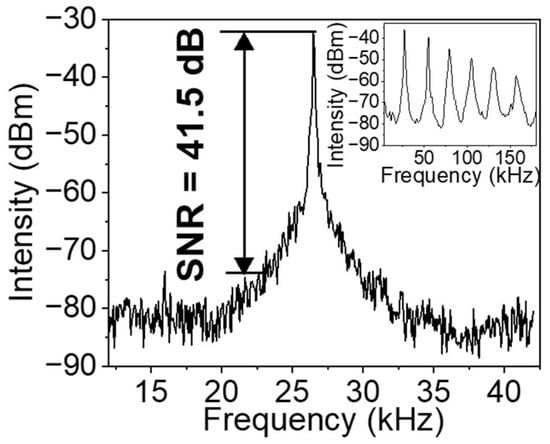
Figure 6.
RF spectrum at the fundamental frequency of 26 kHz; inset: RF spectrum over a range of 150 kHz.
Table 1 presents a comparison between our work and recently reported QS fiber lasers operating near 2 µm, which employ various materials as SAs. Notably, this study introduces glycerin as an SA for the first time at this wavelength range for QS operation, thus achieving competitive performance with previously reported works.
For instance, A. Rosol et al. obtained QS pulses using gold nanoparticles as the SA, with a pulse energy of 0.01103 µJ and a repetition rate of 36.29 kHz over a tuning range of 1932–1946 nm [8]. X. Zhang et al. used graphene-polyvinyl alcohol (graphene-PVA) composite as the SA, achieving a pulse energy of 0.12 µJ and a repetition rate of 49.64 kHz at a wavelength of 1891 nm [9]. Other materials have been used to generate QS operation at the wavelength of around 2 µm, including Ferroferric Oxide (Fe3O4), Alcohol, Tungsten Trioxide (W03), Titanium Carbide (Ti3C2Tx), and Molybdenum Tungsten Disulfide (MoWS2), all of which reported pulse energies in the nanojoule (nJ) range.
In contrast, our system achieves a significantly higher pulse energy of 1.08 µJ, a lower repetition rate, and higher power output (except for the alcohol-based SA), surpassing the performance of most other reported systems.
While the novelty of our work lies primarily in the introduction of glycerin as a SA, its contribution goes beyond material innovation. Our system offers a compact, cost-effective, and stable QS laser operating over a relatively broad pump power range (1.7 to 2.4 W). It demonstrates favorable QS characteristics, including high pulse energy in the µJ range, low repetition rates, output power in the mW range, and pulse durations on the order of microseconds.
Glycerin, as an SA, offers several practical advantages: it is inexpensive, easy to prepare, stable, and does not require complex synthesis, unlike many conventional SAs listed in Table 1. Furthermore, glycerin is less volatile than alcohol, enhancing the system’s long-term stability. These features position glycerin as a highly accessible and scalable alternative for developing compact and cost-sensitive fiber lasers in the 2 µm region. Therefore, this work not only introduces a novel SA but also proposes a practical approach to efficiently generating high-energy pulses for applications in medical, industrial, and sensing fields.

Table 1.
Comparison of the QS performance for various materials SAs at ~2 µm.
Table 1.
Comparison of the QS performance for various materials SAs at ~2 µm.
| Maximum Pump Power (W) | Central Wavelength (nm) | SA | Repetition Rate | Output Power (mW) | Pulse Energy (µJ) | Reference |
|---|---|---|---|---|---|---|
| 0.130 | 1932–1946 | Graphene-PVA | 36.29 | 0.394 | 0.01103 | [8] |
| 0.930 | 1891 | 1 Gold Nanoparticle | 49.64 | 6.3 | 0.12 | [9] |
| 0.104 | 1982 | 1 Fe3O4 | 40.58 | 1.01 | 0.02129 | [15] |
| 1.42 | 1884.83 | Alcohol | 66.7 | 62 | 0.93 | [16] |
| 0.85 | 1960.2 | 2 WO3 | 64.27 | 8.2 | 0.127 | [23] |
| 0.237 | 1996 | 3 Ti3C2Tx | 33.30 | 3.7 | 0.111 | [24] |
| 0.510 | 1983 | 4 MoWS2 | 36.30 | 3.13 | 0.0864 | [25] |
| 2.4 | 1946 | Glycerin | 26.7 | 30 | 1.08 | This work |
1 Ferroferric-oxide, 2 Tungsten trioxide, 3 Titanium carbide, 4 Molybdenum tungsten disulfide.
4. Conclusions
As per the authors’ knowledge, glycerin has been used as a Q-switcher for PQS operation in the ~2 µm wavelength for the first time. The SA can be easily implemented by filling the gap between two FC/PC connectors with glycerin. In this regard, the TDFL delivers stable QS pulses at the central wavelength of 1946 nm. The PQS operates stably over the 1.7 to 2.4 W pump power range. In this sense, at 2.4 W, the TDFL produces QS pulses with a minimum pulse duration of 2 µs, a maximum repetition rate of 26.7 kHz, and a maximum average output power and pulse energy of 30 mW and 1.10 µJ, respectively. Furthermore, the TDFL shows a SNR of 41.5 dB, indicating a stable QS laser. The glycerin-based SA proves to be a reliable and simple liquid for achieving PQS operation in the 2 µm regime. Moreover, due to the response time of glycerin’s vibration levels and its adjustable modulation depth, ML emission in the 2 µm region can be obtained with this liquid SA.
Author Contributions
Conceptualization, M.D.-S. and E.A.E.-D.-L.-C.; Methodology, M.D.-S.; Validation, B.I.-E. and M.B.-J.; Formal analysis, M.D.-S., E.A.E.-D.-L.-C. and U.A.-B.; Investigation, A.I.-G. and A.R.-M.; Resources, B.I.-E.; Data curation, I.A.-R. and L.A.R.-M.; Writing—original draft preparation, M.D.-S. and E.A.E.-D.-L.-C.; Writing—review and editing, M.D.-S., U.A.-B., B.I.-E. and M.B.-J.; Visualization, M.D.-S. and E.A.E.-D.-L.-C.; Supervision, B.I.-E.; Project administration, B.I.-E. All authors have read and agreed to the published version of the manuscript.
Funding
This work was supported by CONACyT project grant CB-287315.
Data Availability Statement
The data are available upon request to the corresponding author.
Acknowledgments
Edwin E., Ulises A., Adalid I. and Alejandro R. would like to thank the Secretaría de Ciencia, Humanidades, Tecnología E Innovación program.
Conflicts of Interest
The authors declare no conflicts of interest.
References
- Rastgarjazi, M.; Vuong, X.; Gu, X.; Yang, V.X.D. All-fiber passively Q-switched Tm-doped laser with a mode field area mismatched Tm-doped saturable absorber. Biomed. Opt. Express. 2024, 15, 4815–4828. [Google Scholar] [CrossRef]
- Gu, R.; Li, Z.; Lei, C.; Li, S.; Wang, D.; Wang, X. Thulium-Doped Fiber Laser and Its Application in Urinary Lithotripsy. IEEE J. Med. Biol. Eng. 2023, 43, 351–361. [Google Scholar] [CrossRef]
- Lahyani, J.; Gouët, L.; Gibert, F.; Cézard, N. 2.05-µm all-fiber laser source designed for CO2 and wind coherent lidar measurement. Appl. Opt. 2021, 60, C12–C19. [Google Scholar] [CrossRef] [PubMed]
- Mingareev, I.; Weirauch, F.; Olowinsky, A.; Shah, L.; Kadwani, P.; Richardson, M. Welding of polymers using a 2 µm thulium fiber laser. Opt. Laser Technol. 2012, 44, 2095–2099. [Google Scholar] [CrossRef]
- Paschotta, R. Field Guide to Laser Pulse Generation, 1st ed.; SPIE: Bellingham, WA, USA, 2008; pp. 10–22. [Google Scholar]
- Dai, S.; Li, X.; Wu, D.; Nie, Q. Broad-spectrum and all-fiber passively Q-switched Tm-doped fiber laser based on SESAM. Optik 2018, 165, 195–199. [Google Scholar] [CrossRef]
- Ahmad, H.; Samion, M.Z.; Sharbirin, A.S.; Norizan, S.F.; Aidit, S.N.; Ismail, M.F. Graphene-PVA saturable absorber for generation of a wavelength-tunable passively Q-switched thulium-doped fiber laser in 2.0 µm. Laser Phys. 2018, 28, 055105. [Google Scholar] [CrossRef]
- Rosol, A.; Jafry, A.; Mokhtar, N.; Yasin, M.; Harun, S.W. Gold nanoparticles film for Q-switched pulse generation in thulium doped fiber laser cavity. Optoelectron. Lett. 2021, 17, 449–453. [Google Scholar] [CrossRef]
- Zhang, X.; Chu, H.; Li, Y.; Zhao, S.; Li, D. Diameter-selected single-walled carbon nanotubes for the passive Q-switching operation at 2 μm. Opt. Mater. 2020, 100, 109267. [Google Scholar] [CrossRef]
- Tsai, T.Y.; Tsao, H.X.; Huang, C.L.; Chen, W.J. 1590-nm-pumped passively Q-switched thulium all-fiber laser at 1900 nm. Opt. Express 2015, 23, 11205–11210. [Google Scholar] [CrossRef]
- Musa, B.; Lattif, A.A.; Rusdi, M.F.M.; Rahman, M.F.A.; Zulkipli, N.F.; Samsamnun, F.S.M.; Jafry, A.A.A.; Harun, S.W. Q-switched Thulium-doped fiber laser with Bismuth-doped fiber saturable absorber. J. Phys. Conf. Ser. 2019, 1371, 012024. [Google Scholar] [CrossRef]
- Zhang, J.; Wu, D.; Quan, C.; Guo, Z.; Zhao, R.; Wang, R.; Dai, S.; Nie, Q. High-power all-fiber wavelength-widely-tunable Tm3+-doped fiber laser Q-switched by TI-SA. J. Opt. 2019, 21, 085501. [Google Scholar] [CrossRef]
- Li, N.; Jia, H.; Guo, M.; Zhang, J.; Zhang, W.Y.; Guo, Z.X.; Li, M.X.; Jia, Z.X.; Qin, G.S. Broadband Fe3O4 nanoparticles saturable absorber for Q-switched fiber lasers. Opt. Fiber Technol. 2021, 61, 102421. [Google Scholar] [CrossRef]
- Escamilla, B.I.; Sánchez, M.D.; Ramírez, B.P.; Tamayo, R.A.; Baylón, J.A.; Jiménez, M.B.; Cortés, P.P.; Kuzin, E.A. Passively Q-Switched Thulium-Doped Fiber Laser Using Alcohol. IEEE Photonics Technol. Lett. 2018, 30, 1768–1771. [Google Scholar] [CrossRef]
- Zhang, W.; Jiang, H.; Yang, K.; Liu, N.; Geng, L.; Hao, Y.; Xian, T.; Zhan, L. Bright/dark switchable mode-locked fiber laser based on alcohol. Chin. Opt. Lett. 2024, 22, 031403. [Google Scholar] [CrossRef]
- Zhang, W.; Zhang, L.; Xian, T.; Gao, L. Generation of bright/dark pulses in an Erbium-doped fiber laser mode-Locked with glycerin. J. Lightwave Technol. 2019, 37, 3756–3760. [Google Scholar] [CrossRef]
- Laubereau, A.; Von der Linde, D.; Kaiser, W. Direct measurement of the vibrational lifetimes of molecules in liquids. Phys. Rev. Lett. 1972, 28, 1162–1165. [Google Scholar] [CrossRef]
- Burikov, S.; Dolenko, T.; Patsaeva, S.; Starokurov, Y. Raman and IR spectroscopy research on hydrogen bonding in water–ethanol systems. Mol. Phys. 2010, 108, 2427–2436. [Google Scholar] [CrossRef]
- Scholle, K.; Lamrini, S.; Koopmann, P. 2 µm Laser Sources and Their Possible Applications. In Frontiers in Guided Wave Optics and Optoelectronics, 1st ed.; Bishnu Pal.; IntechOpen: Rijeka, Croatia, 2010; pp. 471–496. [Google Scholar] [CrossRef]
- Haus, H.A. Mode-locking of lasers. IEEE J. Sel. Top. Quant. 2000, 6, 1173–1185. [Google Scholar] [CrossRef]
- Garrido, A.I.; Sánchez, M.D.; Pottiez, O.; Jiménez, M.B.; Baylón, J.A.; Rodriguez, L.A.; Rivera, I.A.; Escamilla, B.I. Solitons, single- and synchronous dual-wavelength noise-like pulses and hybrid regimes from a thulium-doped fiber laser. Laser Phys. Lett. 2022, 19, 125101. [Google Scholar] [CrossRef]
- Leon, J.; Lee, J.; Lee, J.H. Numerical study on the minimum modulation depth of a saturable absorber for stable fiber laser mode locking. J. Opt. Soc. Am. B 2015, 32, 31–37. [Google Scholar] [CrossRef]
- Al-Hiti, A.S.; Hassan, H.; Yasin, M.; Harun, S.W. Passively Q-switched 2 µm fiber laser with WO3 saturable absorber. Opt. Fiber Technol. 2023, 75, 103193. [Google Scholar] [CrossRef]
- Buntat, M.A.; Rosol, A.H.A.; Rusdi, M.F.M.; Latif, A.A.; Yasin, M.; Harun, S.W. Ti3C2Tx thin film as a saturable absorber for passively generating Q-switched pulses in thulium-doped fiber laser cavity. Nanosyst. Phys. Chem. Math. 2021, 12, 436–441. [Google Scholar] [CrossRef]
- Ahmad, H.; Sharbirin, A.S.; Ismail, M.F. Molybdenum tungsten disulphide (MoWS2) as a saturable absorber for a passively Q-switched thulium/holmium-codoped fibre laser. J. Modern Opt. 2019, 66, 1163–1171. [Google Scholar] [CrossRef]
Disclaimer/Publisher’s Note: The statements, opinions and data contained in all publications are solely those of the individual author(s) and contributor(s) and not of MDPI and/or the editor(s). MDPI and/or the editor(s) disclaim responsibility for any injury to people or property resulting from any ideas, methods, instructions or products referred to in the content. |
© 2025 by the authors. Licensee MDPI, Basel, Switzerland. This article is an open access article distributed under the terms and conditions of the Creative Commons Attribution (CC BY) license (https://creativecommons.org/licenses/by/4.0/).